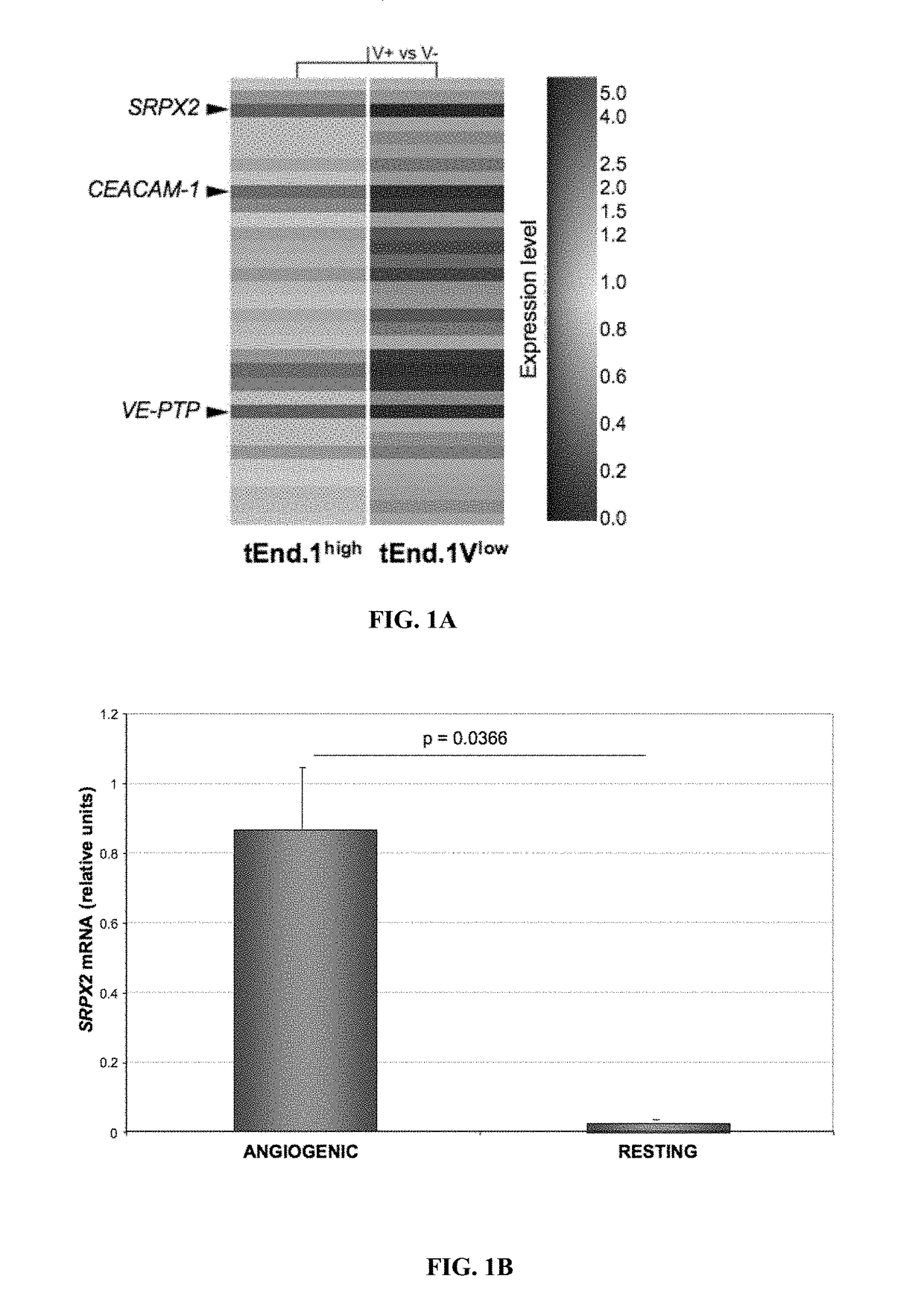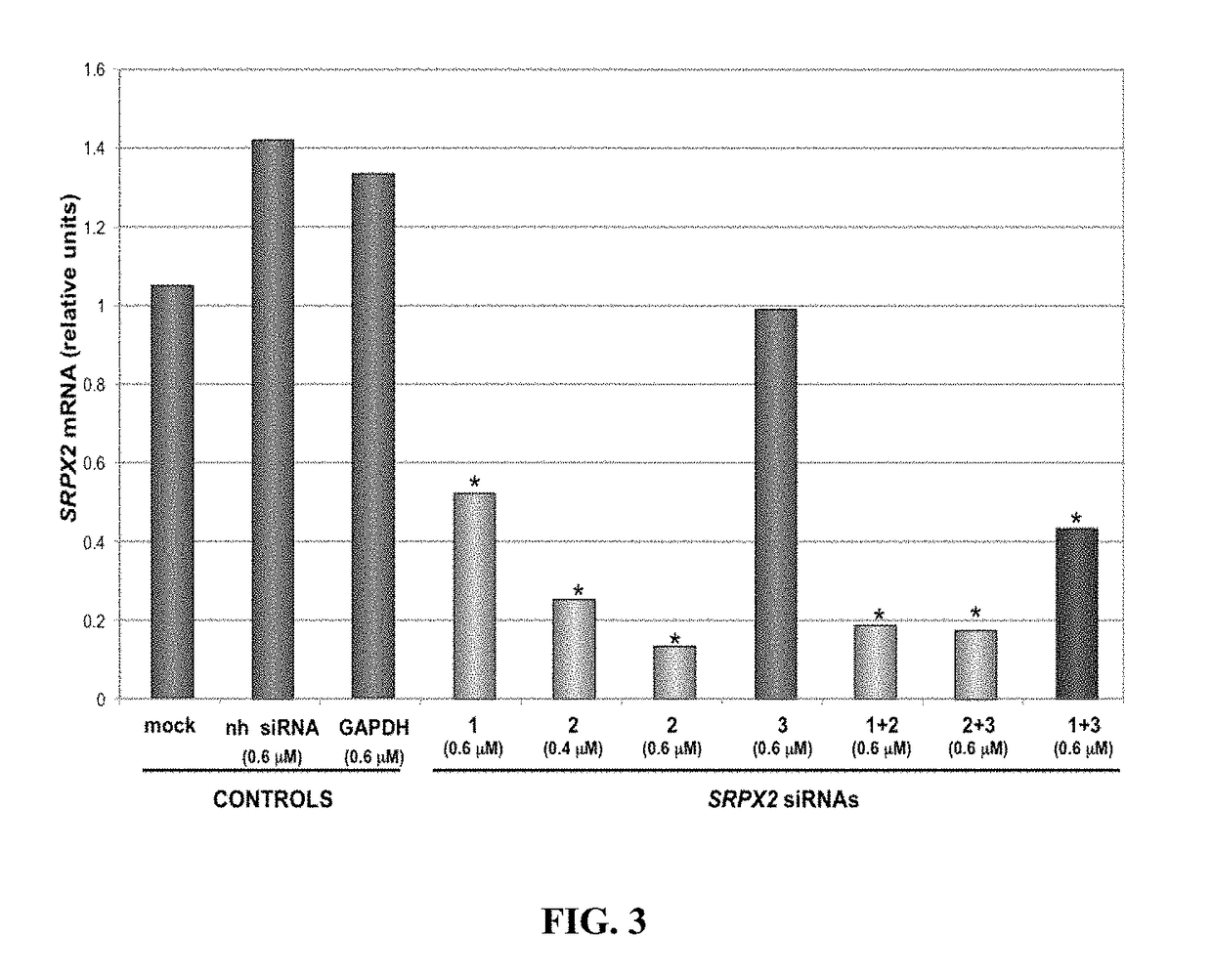Modulation of srpx2-mediated angiogenesis
a technology of angiogenesis and srpx2, which is applied in the field of molecular biology and oncology, can solve the problems of visual loss, insufficient number of blood vessels, and excessive amounts of new blood vessels, and achieve the effects of improving stability, efficacy and bioavailability, and reducing toxicity
- Summary
- Abstract
- Description
- Claims
- Application Information
AI Technical Summary
Benefits of technology
Problems solved by technology
Method used
Image
Examples
example 1
ial SRPX2 Gene Expression in Angiogenic and Resting Endothelial Cells Detected by DNA Microarray Analysis
[0188]The inventors previously isolated subpopulations from an endothelioma cell line with molecular characteristics of angiogenic (t.End.1Vhigh) and resting (t.End.1Vlow) endothelium (Aurrand-Lions et al., 2004). To identify novel genes involved in angiogenesis the inventors examined the gene expression profiles of t.End.1Vhigh angiogenic and t.End.1Vlow resting endothelial cells by DNA microarray technique (GeneChip® Mouse Genome 430 2.0 Array, Affimetrix). Normalization for each gene and comparative analysis between the expression profiles was carried out using GeneSpring software. The t.End.1Vhigh cells express high levels of the integrin αVβ3 and do not endocytose acetylated LDL while t.End.1Vlow have low αVβ3 integrin levels and efficiently take up acetylated LDL. In addition, t.End.1Vhigh show increased cell migration, lack of inflammatory response and form cord-like struc...
example 2
xpression of SRPX2 Gene in Angiogenic Tissue
[0194]Using in situ mRNA hybridization, the inventors found strong vascular expression of SRPX2 in mouse angiogenic tissues. For this purpose, the inventors induced new blood vessel formation by injecting subcutaneously bFGF-treated matrigel plugs in mice. After 14 days, vascularized plugs were harvested, subjected to cryo-sectioning and in situ mRNA hybridization. Double labeling with riboprobes of the vascular marker PECAM-1 and SRPX2 revealed robust expression of SRPX2 mRNA in de novo formed blood vessels in the matrigel plugs (FIG. 2A, upper panel). Then, the inventors investigated whether SRPX2 mRNA would also be expressed in newly formed blood vessels induced by growing Lewis lung carcinoma (LLC1) in mice. Similarly to the bFGF-treated matrigel plugs, SRPX2 was co-expressed by PECAM-1-positive blood vessels in tumors (FIG. 2A, lower panel). The inventors then investigated SRPX2 expression at the protein level using the same tissue. D...
example 4
of SRPX2 Gene Leads to Modulation of Migratory Capacities of t.End.1Vhigh Angiogenic Cells In Vitro
[0201]During angiogenesis endothelial cells migrate to form sprouts and vascular tubes. Since the inventors previously showed that tEnd.1Vhigh cells migrate efficiently, they used them in order to study weather SRPX2 would influence cell migration in the wound-healing assay. Since angiogenesis is dependent on cell migration the inventors further evaluated whether silencing of the SRPX2 gene in angiogenic cells would affect their migration, as tested by a wound-healing assay using Matrigel™-coated plates. The disruption of the t.End.1Vhigh monolayers induced the cells at the edge of the wound to spread rapidly and migrate onto the Matrigel™. The leading front of the cell monolayer migrated homogenously as a unit during 16 hours (FIG. 4A). Photographs of the migrating cells were taken by the ImageXpress device at the beginning of the healing process and after 16 hours. This period was su...
PUM
 Login to View More
Login to View More Abstract
Description
Claims
Application Information
 Login to View More
Login to View More - R&D
- Intellectual Property
- Life Sciences
- Materials
- Tech Scout
- Unparalleled Data Quality
- Higher Quality Content
- 60% Fewer Hallucinations
Browse by: Latest US Patents, China's latest patents, Technical Efficacy Thesaurus, Application Domain, Technology Topic, Popular Technical Reports.
© 2025 PatSnap. All rights reserved.Legal|Privacy policy|Modern Slavery Act Transparency Statement|Sitemap|About US| Contact US: help@patsnap.com



